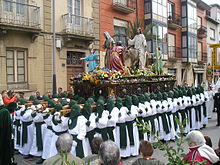Confraternity

A confraternity (
History
Pious associations of laymen existed in very ancient times at Constantinople and Alexandria. In France, in the eighth and ninth centuries, the laws of the
Confraternities had their beginnings in the early Middle Ages, and developed rapidly from the end of the twelfth century. The main object and duty of these societies were, above all, the practice of piety and works of charity.[2]
Some confraternities were very widely spread, especially in the cities of the
Various other congregations such as of the Holy Trinity, of the Scapular, etc., were founded between the thirteenth and sixteenth centuries. From the latter century onwards, these pious associations have multiplied greatly.
Membership
Each Confraternity organization has a set of rules or by-laws to follow which every member promises to live by. Even though the Catholic Church works in harmony with the confraternity, these rules are not religious vows, instead merely rules set up to govern the confraternal organization.[5] Some confraternities allow only men, while others allow only women or only youth.
Activities
The religiosity of the members and their desire for a personal reward in the afterlife were reflected in confraternity activities, such as assisting with burials by donating burial robes or monetary payment, attending the burial mass, volunteering in the local hospitals, organization of and participation in religious feast days, giving dowries for local orphans, selling and preparing bread used for local religious holidays, escorting the condemned during the inquisition, burying the dead during epidemics and other charitable acts as deemed appropriate by the confraternity members or parish priest.[6] Society could not function strictly through government programs because there was also a need to take care of matters such as burials, and provide for the poor and indigent. While government can and did maintain programs to handle these needs, they were better managed by lay organizations or the "neighbor helping neighbor" theory.[7]
Examples
The term may have other meanings: The Confraternity of the Immaculate Conception is a renowned lay Marian apostolate in the Philippines known for administering the Grand Marian Procession parade on the Feast of the Immaculate Conception.
The
Members of The Augustana Confraternity, which is in the
See also
- Orthodox Christian Laity
- Brotherhoods (confraternities)
- Confraternities of the Cord
- Confraternity of the Divine Infant of Prague
References
- ^ a b c Fanning, William. "Confraternity (Sodality)." The Catholic Encyclopedia. Vol. 4. New York: Robert Appleton Company, 1908. 3 Jan. 2015
- ^ Hilgers, Joseph. "Sodality." The Catholic Encyclopedia. Vol. 14. New York: Robert Appleton Company, 1912. 17 Aug. 2014
- ISBN 9781580469968
- ^ M.McGahan, Florence. "Confraternities of Penitents." The Catholic Encyclopedia. Vol. 11. New York: Robert Appleton Company, 1911. 3 Jan. 2015
- ^ Christopher Black and Pamela Grovestock, Early Modern Confraternities in Europe and the Americas, (Aldershot, England: Ashgate, 2006), 1.
- ^ Black and Grovestock, Early Modern Cofradias, 19.
- ^ George M. Foster, “Cofradia and Compadrazgo in Spain and Spanish America,” Southwestern Journal of Anthropology, Vol 9 No. 1 (Spring 1953), 11-12.
- ^ Confraternity of the Blessed Sacrament
- ^ Rydecki, Paul A. (4 August 2015). "The Augustana Confraternity". The Augustana Ministerium. Archived from the original on 6 August 2015. Retrieved 1 September 2015.



